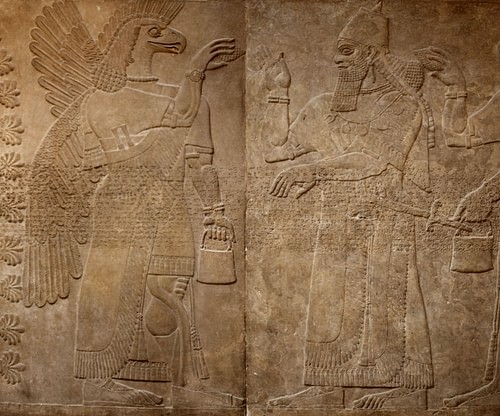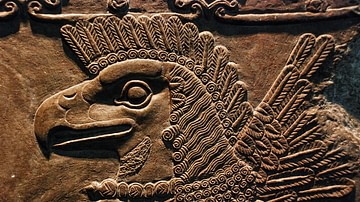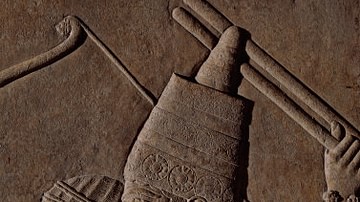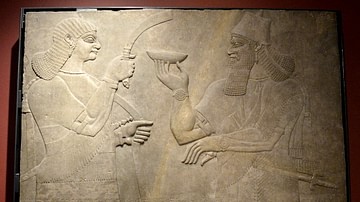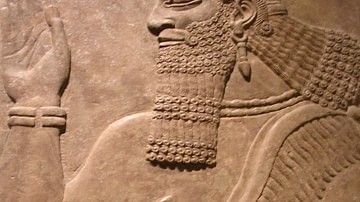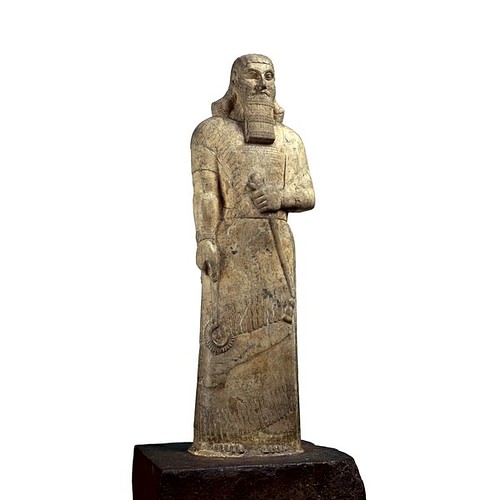
Ashurnasirpal II (r. 884-859 BCE) was the third king of the Neo-Assyrian Empire. His father was Tukulti-Ninurta II (r. 891-884 BCE) whose military campaigns throughout the region provided his son with a sizeable empire and the resources to equip a formidable army. Ashurnasirpal II is known for his ruthless military conquests and the consolidation of the Assyrian Empire, but he is probably most famous for his grand palace at Kalhu (also known as Caleh and Nimrud in modern-day Iraq), whose wall reliefs depicting his military successes (and many victims) are on display in museums around the world in the modern day. In addition to the palace itself, he is also known for throwing one of the most impressive parties in history to inaugurate his new city of Kalhu: he hosted over 69,000 people during a ten-day festival. The menu for this party still survives in the present day. He reigned for 25 years and was succeeded by his son, Shalmaneser III (r. 859-824 BCE).
Early Reign & Military Campaigns
Ashurnasirpal II's grandfather was Adad-Nirari II (r. 912-891 BCE), generally considered the first king of the Neo-Assyrian Empire, who initiated the revitalization of the government and the military. His diplomatic skills, especially his treaty with Babylon, ensured stability in the empire, while his military conquests enriched the treasury and expanded the empire's borders. His son continued his policies so that, by the time Ashurnasirpal II came to the throne, he had at his disposal a well-equipped fighting force and considerable resources. He put both of these to use almost at once. He was not so much interested in expansion of the empire as in securing it against invasion from without or rebellion from within. He also was required, as an Assyrian king, to combat the forces of chaos and maintain order. The historian Marc Van De Mieroop writes:
The king, as representative of the god Assur, represented order. Wherever he was in control, there was peace, tranquility, and justice, and where he did not rule there was chaos. The king's duty to bring order to the entire world was the justification for military expansion. (260)
While Ashurnasirpal may not have considered expansion a priority, he certainly took order in his realm very seriously and would not tolerate insubordination or revolt.
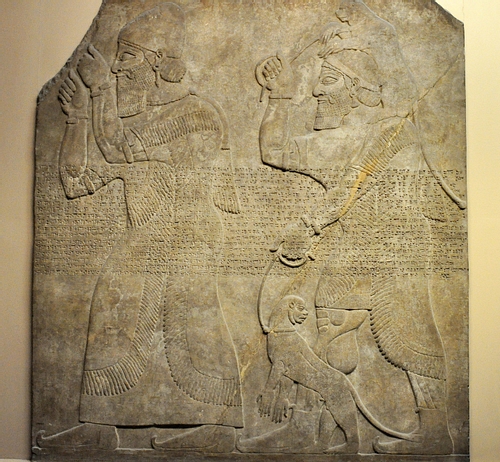
His first campaign was in 883 BCE to the city of Suru to put down a rebellion there. He then marched to the north where he put down other rebellions that had broken out when he took the throne. He was not interested in having to expend more time and resources on future rebellions and so made an example of the rebels in the city of Tela. In his inscriptions he writes:
I built a pillar over against the city gate and I flayed all the chiefs who had revolted and I covered the pillar with their skins. Some I impaled upon the pillar on stakes and others I bound to stakes round the pillar. I cut the limbs off the officers who had rebelled. Many captives I burned with fire and many I took as living captives. From some I cut off their noses, their ears, and their fingers, of many I put out their eyes. I made one pillar of the living and another of heads and I bound their heads to tree trunks round about the city. Their young men and maidens I consumed with fire. The rest of their warriors I consumed with thirst in the desert of the Euphrates.
This treatment of defeated cities would become Ashurnasirpal II's trademark and would include skinning insubordinate officials alive and nailing their flesh to the gates of the city and “dishonoring the maidens and boys” of the conquered cities before setting them on fire. With Tela destroyed, he moved swiftly on to other campaigns. He marched west, fighting his way through other rebel outbreaks and subjugating the cities which opposed him.
The historian John Boardman notes that “a major factor behind the increasing resistance was probably the heavy tribute exacted by Ashurnasirpal…one has the impression that a particularly large amount of booty was claimed by this king and that corvee [forced labor] was imposed universally” (259). Ashurnasirpal II led his army on successful campaigns across the Euphrates River and all the way to the Mediterranean Sea, where he washed his weapons as a symbol of his conquests (an act made famous by the inscriptions of Sargon the Great of the earlier Akkadian Empire after he had established his rule).
Although some sources claim he then conquered Phoenicia, it seems clear he entered into diplomatic relations with the region, as he did also with the kingdom of Israel. The surviving populace of the cities and territories he conquered were, as per Assyrian policy, relocated to other regions in the empire in order to distribute skills and talent. Having accomplished what he set out to do on campaign, he turned around and headed back to his capital city of Ashur. If there were any further revolts to be put down on his march back, they are not recorded. It is unlikely that there were more revolts, however, as Ashurnasirpal II had established a reputation for cruelty and ruthlessness which would have been daunting to even the most ardent rebel. The historian Stephen Bertman comments on this:
Ashurnasirpal II set a standard for the future warrior-kings of Assyria. In the words of Georges Roux, he "possessed to the extreme all the qualities and defects of his successors, the ruthless, indefatigable empire-builders: ambition, energy, courage, vanity, cruelty, magnificence" (Roux 1992:288). His annals were the most extensive of any Assyrian ruler up to his time, detailing the multiple military campaigns he led to secure or enlarge his nation's territorial dominion. From one raid alone he filled his kingdom's coffers with 660 pounds of gold an equal measure of silver, and added 460 horses to his stables. The sadistic cruelty he inflicted upon rebel leaders was legendary, skinning them alive and displaying their skin, and cutting off the noses and the ears of their followers or mounting their severed heads on pillars to serve as a warning to others. (79-80)
Having secured his empire, Ashurnasirpal II turned his attention to his capital at Ashur, which he renovated (as he also did with Nineveh and many other cities during his reign). Ashur was among the most prosperous of the Assyrian cities and had been the capital of the Assyrian Empire since the reign of Adad Nirari I (1307-1275 BCE). Once he had added his own adornments and improvements to the great city, Ashurnasirpal II now felt it was time for a change in its status. The residents of Ashur were proud of their city and of their prestige as citizens of the capital. It has been proposed by a number of scholars that Ashurnasirpal II wanted a completely new city, with a new population, that he could call his own in order to elevate his name above his predecessors and rule over a populace devoted to him, rather than to their city. This is only one theory, however, as it is not clear what exactly motivated him to move the capital from Ashur. No matter the reason, he chose the city of Kalhu and initiated his building project there.
Kalhu & the Grand Palace
Kalhu had been an important trading center since the 1st millennium BCE. It was located directly on a prosperous route between Ashur and Nineveh. The city had been built on the location of an earlier business community under the reign of Shalmaneser I (1274-1245 BCE) but had become dilapidated over the centuries. Ashurnasirpal II ordered the debris removed from the crumbling towers and walls and decreed a completely new city should be built, which would include a royal residence greater than that of any previous king. Ashurnasirpal II's inscriptions regarding Kalhu read:
The former city of Caleh, which Shalmaneser, king of Assyria, a prince who preceded me, had built, that city had fallen into decay and lay in ruins, it was turned into a mound and ruin heap. That city I built anew. I laid out orchards round about it, fruit and wine I offered unto Assur, my lord, I dug down to the water level. I built the wall thereof; from its foundation unto its top I built and completed it.
The new city of Kalhu covered 360 hectares (890 acres) with a surrounding wall of 4.6 miles (7.5 kilometers). When it was completed, Ashurnasirpal II relocated an entirely new population (16,000 people) within the city's walls and took up residence in his new palace. According to the historian Karen Radner:
Kalhu's most impressive building at the time of Ashurnasirpal was certainly his new royal palace. At 200 metres long (656 feet) and 130 metres wide (426 feet), it dominated its surroundings and its position on the citadel mound led to its modern name, the Northwest Palace. It was organised around three courtyards, accommodating the state apartments, the administrative wing and the private quarters which also housed the royal women. Here, several underground tombs were uncovered in 1989, including the last resting place of Ashurnasirpal's queen Mullissu-mukannišat-Ninua, the daughter of the king's cupbearer, one of the foremost officials at court. Her rich burial goods give a vivid impression of the luxury in which the king and his entourage lived. (1)
In 879 BCE, when the palace was completed and fully decorated with the reliefs lining the walls of its corridors, Ashurnasirpal II invited the surrounding population and dignitaries from other lands to celebrate. The festival lasted ten days, and his Banquet Stele records that 69,574 people attended. The menu from this celebration included but was not limited to 1,000 oxen, 1,000 domestic cattle and sheep, 14,000 imported and fattened sheep, 1,000 lambs, 500 game birds, 500 gazelles, 10,000 fish, 10,000 eggs, 10,000 loaves of bread, 10,000 measures of beer, and 10,000 containers of wine. When the celebration was done, he sent his guests home “in peace and joy” after allowing the dignitaries to view the reliefs in his new palace.
His famous Standard Inscription told again and again of his triumphs in conquest and vividly depicted the horrible fate of those who rose against him. The inscription also let the dignitaries from his own realm, and others, know precisely who they were dealing with. He claimed the titles “great king, king of the world, the valiant hero who goes forth with the help of Assur; he who has no rival in all four quarters of the world, the exalted shepherd, the powerful torrent that none can withstand, he who has overcome all mankind, whose hand has conquered all lands and taken all the mountain ranges” (Bauer, 337). His empire stretched across the territory which today comprises western Iran, Iraq, Syria, Jordan, and part of Turkey. Through his diplomatic relationships with Babylonia and the Levant, he also had access to the resources of southern Mesopotamia and the seaports of Phoenicia. In the understanding of the people of the Near East at that time, he really was “king of the world”.
Death & Succession
After a reign of 25 years, during which he completed a number of significant building projects throughout the empire, succeeded in 14 military campaigns, and established depots of food and water reserves for the people, Ashurnasirpal II died. He was succeeded by his son Shalmaneser III who reigned from 859 to 824 BCE. Shalmaneser III continued and improved upon his father's policies and expanded the empire through the kinds of military campaigns the Assyrian kings had now become famous for. He was enabled in this by the strength of the empire his father had provided. The historian Wolfram von Soden writes:
The reign of Ashurnasirpal II, marked by brutal but systematic military advances, represented the high point of the first great period of Assyrian expansion. During this king's tenure, he resettled great portions of those ethnic groups still intent on remaining autonomous, in an intensifying application of the policy the Assyrian kings had employed against rebellious subjects since the thirteenth century. (56)
Shalmaneser III inherited a stronger and more capable empire than his father even had and built upon his predecessor's successes. While Ashurnasirpal II's policies may have been brutal, they were also effective in maintaining control of the population. Through his ruthless campaigns, the resettlement of populations, and his careful administration, Ashurnasirpal II consolidated the political entity that would become the greatest empire in the ancient Near East and established his name among the most memorable Assyrian kings.
